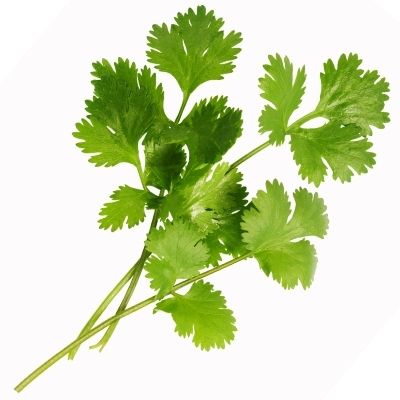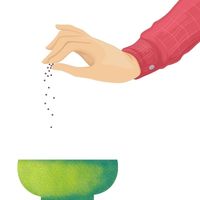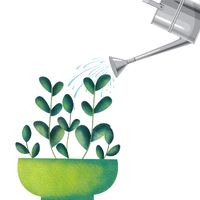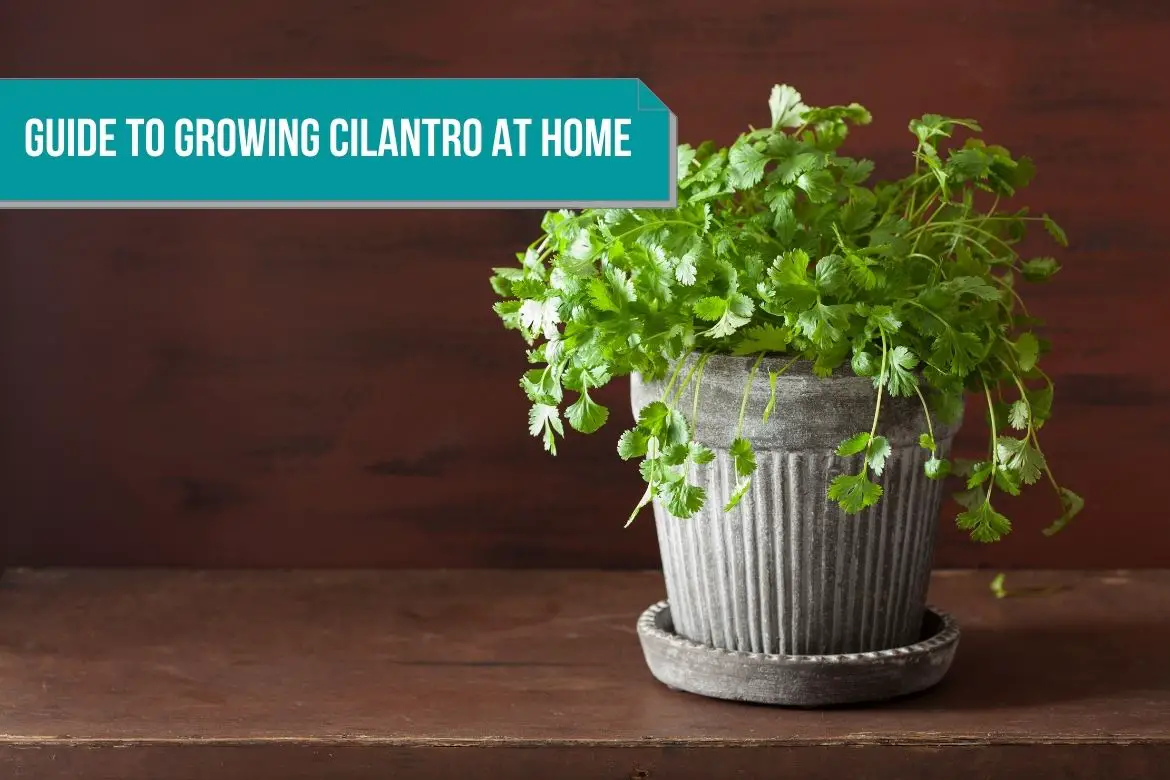
Botanical name : Coriandrum sativum
Flavor Profile : Similar flavor as parsley but stronger with undertones of spice, mint, pepper, citrus and tangy
Cilantro, an annual herb, belongs to the same family as other aromatic plants such as celery, carrot and parsley. It is also known as Mexican parsley, coriander leaves or Chinese parsley.
The leaves of cilantro are light green, feathery, and flat. As an herb, the leaves are used, but the dried seeds, called “coriander seeds” or just plain “coriander”, are used as a spice.
A seed spice crop, coriander is one of humanity’s oldest and most important crops.
Its leaves are similar to those of European parsley, but it has a pungent, sweet-musky odor and taste that some people do not like. The flavor of the leaves has been described as citrusy with a biting tang, soapy, or like (believe it or not) crushed bed bugs.
Native to southern Europe and Asia, cilantro is now cultivated throughout the world. The herb has been cultivated in India and China for thousands of years. In Mexico and Peru, it was introduced by the Spanish conquistadors.
Mexico is one of the largest exporters of cilantro. The state of California is the top producer of cilantro in the U.S.
Cilantro is known primarily as a cooking herb. It does, however, appear to play a greater medicinal role in other cultures, such as those of India, Iran, Pakistan, and Morocco.
FUN FACT : Cilantro was named “Herb of the Year 2017” by the International Herb Association.
Varieties of cilantro
- California Long Standing
- Caribe
- Costa Rica
- Delfino
- Jantar
- Leisure
- Lemon
- Moroccan
- Santos
- Slo Bolt
- Terra
Health benefits of Cilantro
Cilantro contributes significantly to the removal of heavy metals from the body.
Traditionally, coriander seeds have been used to treat indigestion, worm infestations, rheumatism, loss of appetite, convulsions, insomnia, anxiety, and joint pain.
Coriander is widely used today to treat digestive disorders, respiratory and urinary disorders, anxiety and insomnia, allergies, amoebic dysentery, burns, coughs, cystitis, dizziness, edema, hayfever, headaches, hemorrhoids, rashes, urinary-tract infections, urticaria, and vomiting.
It is also believed to help in alleviating type 2 diabetes and balance fasting blood sugar level. Also, it has cholesterol lowering properties.
Because of its antiseptic, antibacterial, and antibacterial properties, cilantro is also used topically to treat skin inflammations, eczema and joint pain. It also makes a good herbal sunscreen.
Cilantro has a high content of vitamin A, K and C along with minerals like manganese, folate and potassium.
Please refer complete nutrition fact of cilantro for more details
How to grow Cilantro indoors
Cilantro is a cool season crop which grows best in cool and dry summer climates. Cilantro falls under zone 2-11.
High humidity and frequent rain are not ideal for growing cilantro.
After the last spring frost date, seeds can be planted in the soil. However, it also depends on climate. For instance, in a state like Texas, It is best to plant cilantro in February for a harvest in April and again in September for a harvest in November.
Cilantro is capable of growing in a wide range of climates. It will, however, bolt (going to seed, prematurely produces flowers) due to the hot weather during the summer months. This will significantly reduce the foliage of the plant. Also, it can not survive frost.
The young plants produce wide, flat leaves, but when they begin to bolt, they produce lacy and fern-like leaves along the lower stalk.
Plant size

Foliage is 12 -18 inches (30 – 45 cm) . However, the flowering stem can reach heights of 2 – 3 feet (60 – 90 cm)
Container / pot Size

18 inches Diameter ( 45 cm )
Refer how to choose the right container for your indoor plants for more details.
Sunlight

Full Sun. However, avoid harsh direct sunlight.
It can also grow in partial sunlight.
For best results in growing cilantro indoors, place the container near a large south facing window. Or you can place the container near east or west facing windows or windowsills. Placing under a skylight under direct sun should be avoided if other options are available.
Refer Best locations and Light requirements for indoor plants for more details.
Soil

Fast draining, light, and rich in organic matter potting mix.
Check the content of the potting mix. A potting mix with high perlite content or sand mix is considered ideal for growing cilantro in container.
Please refer components of potting mix for more details on perlite.
Cilantro thrive on a soil with pH range 6.5.
Climate and soil temperature of 50-85 degrees F (10-30 C) is advisable.
You can mix compost in the potting mix in the ration of 50:50.
Sowing

Sown by seeds in early spring, much like lettuce. Soak the seeds in water for 2-3 days. After this dry the seeds before sowing.
Plant seeds 1/4th or 1/2 of an inch deep in the potting mix.
Cilantro does not transplant well because of its long taproot. Hence, while sowing the seed choose a permanent container.
As soon as well developed seedlings with true leaves develop, thin them 3-6 inches apart. However, if you are growing cilantro for seeds then then the seedlings 12 inches apart.
It takes 40 to 45 days for a cilantro crop to mature.
Home gardeners won’t have to purchase a lot of seeds each season since there are approximately 2,000 coriander seeds in an ounce.
Quick tip: As cilantro loves moist soil, at the time of sowing you can cover the potting soil with wet paper towel. This will help in reducing the moisture loss specially in hot weather.
Watering

Water the cilantro plant regularly. Keep the soil moist but not over-saturated with water. Over water will lead to leaf diseases.
During germination and establishment of a seedling, water is of the utmost importance for cilantro. Once established, cilantro does not require much water.
Its crucial to have good drainage system in the container along with the potting mix. Cilantro has deep taproot. Ensuring good drainage of the container will prevent the deep roots.
Refer How to make drainage holes on potting container for more details.
Harvesting

The leaves of cilantro can be harvested 45 to 70 days after seeding.
Once the plant is 4 to 6 inches long, harvest the exterior leaves. The plant will produce new leaves if the older, outer leaves are harvested.
The younger leaves have more intense flavor.
You can also cut the whole plant about an inch or two above the soil level to harvest both the small and large leaves. This will allow the plant to regrow for the second harvest.
Seeds should be harvested after they turn a light brown and the plant is dried, usually 2-3 weeks after flowering.
You should cut the stems before they have shattered much, and hang the plants in a warm, well-ventilated area to dry. If a lot of seeds fall from the cut stems, drape a cloth over the step to catch the seeds, or put the stalk inside a paper bag. It is important to completely dry the fruit so the seeds can develop their flavor.
Plant care

Plant in the fall if you live in a hot, sunny climate and give plants some shade. Overheated cilantro will begin to seed quickly.
Weeds are often found near cilantro plants. To prevent weeds, weed regularly or use mulch around plants.
By harvesting often and cutting off flowers as you see them, you can encourage new leaves to grow.
SUBSTITUTES FOR CILANTRO IN THE KITCHEN
- Culantro
- Basil
- Parsley
How to keep Cilantro fresh
Cilantro can be stored in crisper section of the refrigerator for about 14 days in a zip lock bag or container. OR Keep a “bouquet” of leaves in water in the refrigerator to maintain freshness.
Cilantro can be freeze stored in ice trays in the freezer if you wish to store cilantro for a long time.
Dried cilantro can be consumed as well. However, i would recommend not to dry it as it looses a significant amount of flavor.
Ideally, coriander seeds can be stored in an air-tight container in a cool, dark place for many months.
Please refer to how to store herbs and spices for more details.
How to use Cilantro in the kitchen
Fresh cilantro leaves can be used in salads, salsa, and meat dishes, and can add a subtle zest to omelets.
These seeds, also known as coriander, have a distinctive orange flavor and are used in pastries, sausages, and cooked fruit, as well as pickling spices and curry spices.
Chinese soups and Mexican salsa often include cilantro. Cilantro is also added to some Mexican dishes. Pickles, curries, and chutneys in Arabic cooking use both leaves and seeds.
To avoid overcooking cilantro, add it at the very end of cooking.
Dishes : Salads, dips, soup, stir-fries, sauces, marinades, dressings, omelets, stews, curries, dips.
Preparation : Used in whole or chopped form.
Pairing Cilantro with food
Seasoning : Chili peppers, lemon juice and zest, Garlic, marjoram, jalapeño, lime juice and zest, basil, red pepper flakes, paprika, parsley, fennel, chives, chipotle peppers, lemongrass, makrut lime, coriander seeds, fish sauce, garlic, galangal, ginger, saffron, soy sauce, cayenne, curry powder, scallions, oregano, mint, turmeric, cumin .
Fruits and Vegetables : avocado, Potatoes ( White Potato, Red Potato, Russet Potato, Purple Potato ), carrots, tomatoes, onions, jicama, mango, tomatillos, lettuces (Romaine lettuce, leaf lettuce, iceberg lettuce), corn.
Proteins : Fish and seafood, Eggs, goat, lamb, beef, lentils, pork, cheeses, beans, chicken.

